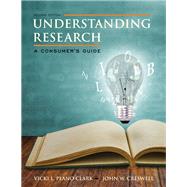NOTE: Used books, rentals, and purchases made outside of Pearson
If purchasing or renting from companies other than Pearson, the access codes for the Enhanced Pearson eText may not be included, may be incorrect, or may be previously redeemed. Check with the seller before completing your purchase.
This package includes the Enhanced Pearson eText and the loose-leaf version
This introductory text is written specifically for consumers of research — anyone who uses the results and implications of research studies to enhance their knowledge and improve their practice. The focus is on guiding students toward a basic understanding of the research process, allowing them to develop the skills, knowledge and strategies needed to read, interpret, and evaluate the quality of research reports. The text provides balanced coverage of quantitative, qualitative, and combined research approaches. The Enhanced Pearson eText features interactive learning modules and assessments.
Improve mastery and retention with the Enhanced Pearson eText*
The Enhanced Pearson eText provides a rich, interactive learning environment designed to improve student mastery of content. The Enhanced Pearson eText is:
- Engaging. The new interactive, multimedia learning features were developed by the authors and other subject-matter experts to deepen and enrich the learning experience.
- Convenient. Enjoy instant online access from your computer or download the Pearson eText App to read on or offline on your iPad® and Android® tablet.*
- Affordable. Experience the advantages of the Enhanced Pearson eText along with all the benefits of print for 40% to 50% less than a print bound book.
*The Enhanced eText features are only available in the Pearson eText format. They are not available in third-party eTexts or downloads.
*The Pearson eText App is available on Google Play and in the App Store. It requires Android OS 3.1-4, a 7” or 10” tablet, or iPad iOS 5.0 or later.
0133831620 / 9780133831627 Understanding Research: A Consumer's Guide, Loose-Leaf Version with Enhanced Pearson eText -- Access Card Package
Package consists of:
- 0132902230 / 9780132902236 Understanding Research: A Consumer's Guide, Loose-Leaf Version
- 0133398900 / 9780133398908 Understanding Research: A Consumer's Guide, Enhanced Pearson eText -- Access Card
From reviews of the book:
"The structure of the book is great. [The authors use] language that helps the reader become engaged and invites them to start applying what they have learned to their situation immediately. The examples of the journal articles with the notations are very helpful and we use these for discussion in the class quite a bit. I also like the 'reviewing what we’ve learned' and 'practicing your skills' at the end of the chapter. I much prefer the consumer approach of this text over others on the market."
-- Candyce Reynolds, Portland State University
"Understanding Research is true to its name; it is much more user friendly, it explains WHAT research IS. It does an EXCELLENT job of covering all of the material I currently cover. [The authors] (fortunately) force me to provide a balanced, comparative description of both [quantitative and qualitative] research. . . . I find the writing style to be clear, interesting and engaging. "
-- Carol A. Friesen, Ball State University












